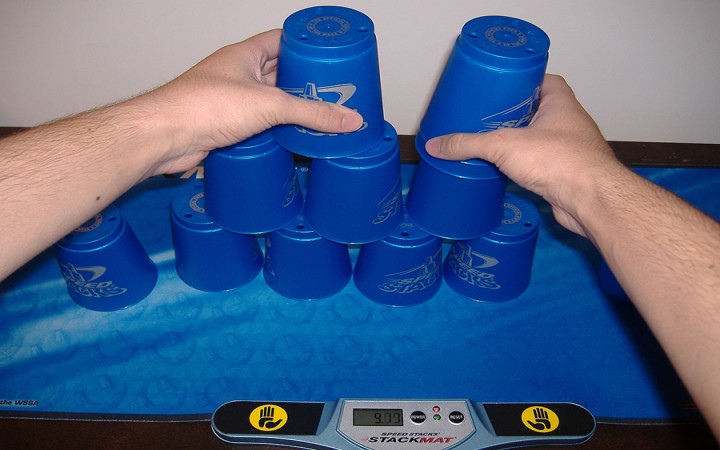Today’s Wonder of the Day was inspired by Lily. Lily Wonders, “How can I make my reaction time fast?” Thanks for WONDERing with us, Lily!
Do kids really need all of those fancy, modern electronic gadgets to have fun? Sure, the latest and greatest smartphones and video game consoles are awesome, but are they necessary?
Maybe your sights turn to those gadgets as you grow older, but we'll bet that you had fun with much simpler toys when you were younger. If you have a baby brother or sister at home, you might already know how much fun they can have with a few pots and pans or a stack of plastic cups.
Pots and pans make beautiful music as an impromptu drum set. Plastic cups can be stacked in all sorts of ways to make anything from a wall to a pyramid. In fact, cup stacking has actually turned into a popular sport over the last couple of decades.
If you don't already have a cup stacking program as part of your physical education (P.E.) curriculum at school, then you may have seen YouTube videos of competitive cup stackers stacking and unstacking cups at a breakneck pace.
How did the simple act of stacking plastic cups turn into a worldwide phenomenon that millions of people all over Earth have fun with at hundreds of competitions every year? Historians trace cup stacking's roots back to a Boys & Girls Club in Oceanside, California, in the early 1980s.
It was there that director Wayne Godinet dreamed up a new game played with simple plastic Dixie cups. He asked kids to stack cups in a pyramid, run and touch a wall, and then return to stack the cups into a pyramid again.
The kids loved the game so much that they asked to play it over and over. The kids inspired Godinet to turn the activity into a sport when he saw that it was an activity that leveled the playing field, allowing kids of all ages and abilities to compete and improve their self-esteem.
Godinet patented a cup stacking kit in 1986. Within a few years, cup stacking programs had been started in schools and clubs in 37 states. Today, you can find cup stacking programs in nearly 60 countries and the P.E. curricula of nearly 47,000 schools around the world.
In 1990, one of Godinet's club kids, a 9-year-old boy named Matt Adame, showed off his cup stacking skills on "The Tonight Show" with Johnny Carson. That appearance inspired Bob Fox, a P.E. teacher in Colorado, to start his own company, Speed Stacks, Inc., to sell cup stacking sets.
Speed Stacks brought more popularity and formal structure to the sport of cup stacking, which is also often called sport stacking or speed stacking. Today, the sport has a governing body, the World Sport Stacking Association, which holds regional tournaments and the world championships. Cup stacking has also been an A.A.U. Junior Olympics event since 2012.
Competitive stackers compete in three individual events during tournaments: (1) the 3-3-3 (three stacks of three cups each); (2) the 3-6-3 (three stacks of three, six, and three cups); and (3) the cycle (a precise sequence of three formations). Winners are judged based upon the fastest times in the three events.
Cup stacking continues to be a sport dominated by young kids and teenagers of all walks of life. At competitions, you will find a mixture of boys and girls with all sorts of interests and abilities. You'll also find competitors who have physical or mental disabilities that might preclude them from involvement in other sports. In particular, there are a number of world-class stackers with autism.
If you ask kids why they love cup stacking, they'll tell you it's simply fun. Professionals who have studied the sport, however, will tell you it has other benefits beyond mere fun. Stacking can improve hand-eye coordination, quickness, ambidexterity, bilateral proficiency, concentration, creativity, rhythm, focus, sequencing, and patterning. Improvements in these areas can lead to gains in reading, math, music, and technology skills.




